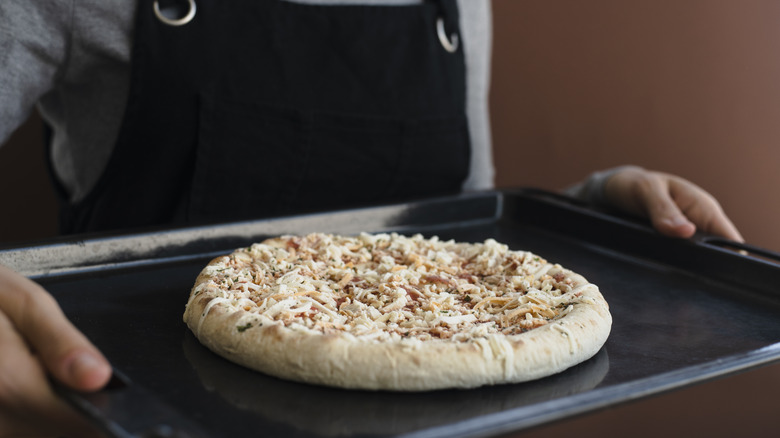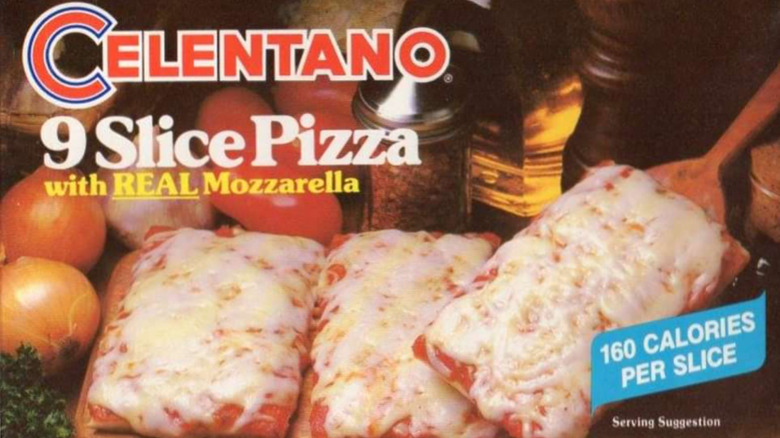The Mystery Behind The World's First Frozen Pizza
Convenience and cheesy goodness are two characteristics that make frozen pizza a go-to in most homes. But who originated the brilliant idea to turn this favorite food into a frozen grocery store item that you can simply heat and enjoy at home?
Totino's and Tombstone have often been touted as the first national brands to introduce frozen pizza, both bringing their products to grocery stores in 1962. However, they were actually beaten to the finish line by Celentano Brothers who did the same thing five years earlier in 1957.
Celentano Brothers began as a specialty shop for Italian goods in Newark, New Jersey in 1947. Initially, they sold fresh ingredients for Italian cooking, like authentic Parmesan and salami. They then laid the foundation for the frozen pizza market using the ingredients and expertise they had readily available to them in their store.
The Celentanos' frozen treat was the first to be marketed nationally across the U.S., and they set themselves apart from swiftly emerging competition by selling square, rather than round, frozen pizzas. It continued to be a firm favorite in American households until 2000, when Rosina Food Products, Inc. bought the company and opted to only continue with its equally popular frozen pasta products.
The evolving technology behind flash-frozen pizzas
As early as the 1920s, innovators were experimenting with how to freeze popular meals for sale in grocery stores on a national scale. American inventor and entrepreneur Clarence Birdseye introduced the first large-scale version of flash-freezing foods after observing the traditional preservation methods of Arctic communities.
The rise in frozen pizza wouldn't happen until three decades later, however. In 1950s America, an influx of Italian immigrants led to a steady increase in the popularity of fresh, hot pizza, but there was still plenty of room for improvement when it came to freezing them. Frozen pizza was initially unappealing because the technique used back then left ice crystals in the dough, which, when defrosted, would melt and result in a soggy crust.
In 1954, Joseph Bucci patented a method for freezing pizza that eliminated this problem. The solution lay in an edible sealing agent that preserved the flavor, consistency, and different textures of the dough, tomato base, and toppings of a frozen pizza when heated.
Since Bucci's patent, the technology for freezing pizza has continued to improve. In 1995, Kraft made a significant breakthrough in the frozen pizza market by introducing the rising-crust option. This technology (which included new and improved packaging and secret ingredients) allowed the crust of the pizza to rise and become fluffy as it warmed in the oven, bringing frozen pizza one step closer to its fresh, restaurant-served counterpart.
How to make your frozen pizza a gourmet experience
Frozen pizzas provide a fantastic base to get creative and customize your meal just the way you like it. If you want an extra crunchy crust that emulates the light charring and crispness of pizza fresh from a brick oven, you can ignore the heating instructions on the packaging and instead preheat your oven to 500 degrees Fahrenheit to cook it. Just be sure to monitor the pizza closely as you don't want to risk burning it.
For many pizza fans, the crust is the real highlight, and you can make it extra flavorful on a frozen pie by seasoning it and adding fat in the last few minutes of cooking. To do so, sprinkle salt and pepper and slash some high-quality extra virgin olive oil on your crust two to three minutes before removing the pizza from the oven. You can also add minced garlic, Parmesan cheese, or chili flakes.
Adding cold, fresh toppings after cooking can also give your frozen pizza a boost. Scatter chopped spring onion, freshly sliced red onion, or fresh herbs like basil to amp up your frozen pizza's flavor and freshness.



